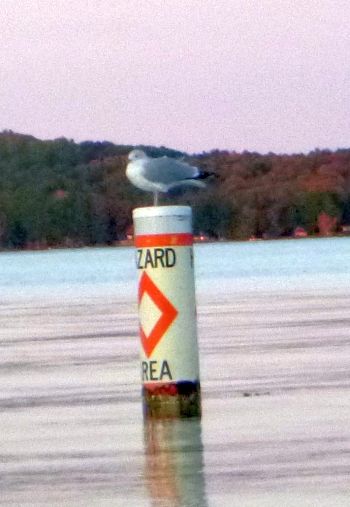
Who Puts Out the Lake Markers?

Don’t you wonder who installs and maintains the marker buoys on our Maine state lakes? Well, here’s what I found out — and what I recall.
The State of Maine has been marking the lakes with navigational buoys since the 1960s. Over the years, various agencies within our government have been tasked with doing the job. Currently, the Bureau of Public Lands spearheads the responsibility with three full-time employees. The team currently is responsible for marking and maintaining the buoys for forty of Maine’s larger lakes, which collectively add up to 2,455. The Department of Agriculture and Conservation and Forestry also permit the marking of thirty or so other smaller lakes by lake associations and municipalities.
There are several different markings on the buoys which impart information to us boaters. Getting familiar with their different meanings, colors etc. takes a little time but soon becomes a good roadmap to keep you and your boat off the rocks and shoals. For instance, like their ocean counterparts, red and green buoys mark navigational channels. Rather than thinking red, right, return; think red and green, go between. Regulatory markers are white with orange stenciling marking shallow areas, dams, and rocks, shoals and other hazards. Obstruction markers are white with black vertical stripes, cautioning boaters to not pass between the buoy and the nearest shore.
As I mentioned earlier, the State of Maine started this program in the early 1960s. Prior to that, lake marking was more helter-skelter, depending on the lake and their own associations. I can only speak to Great and Long Ponds in Belgrade from my early memories of being on these two lakes beginning in the mid 1950s. The Belgrade Lakes Association, nearly a century old now, hired the fishing guides to place navigational aids where needed. The marking system accomplished the same job as the State of Maine has done since 1962, but with different colors of flags. For instance, channel markers such as Mill Stream requires to pass between, were cans hung from overhead wires, or stakes with flags driven into the sand in shallow areas. The vertical stripes of today, placed off peninsulas, were then marked with a black and white flag. Shoals were marked with white only flags to not go between, and single rocks were marked with a red and white flag. Many areas were not marked and when the lake was low on water, one had to be very careful. Common knowledge was relied upon by early mariners on all Maine lakes. Many bent or broken propellers were common and many remain as mantel decorations in the older camps!
I hope you’ve enjoyed this little tidbit and memoir!
— From the shore of Great Pond, your Luckiest Boy contributor, Rod J.
Rod Johnson, a.k.a. “The Luckiest Boy,” is a member of the Belgrade Historical Society.
Download Full Newspaper: High Res | Low Res (Details…)
<— Previous Article • Summaries • Next Article —>
©2025 by Summertime in the Belgrades. All rights reserved.